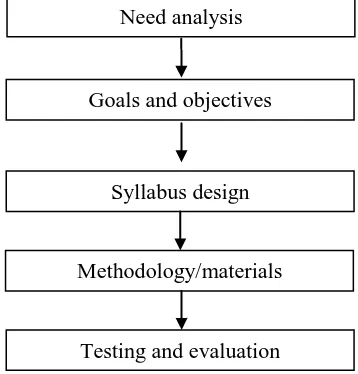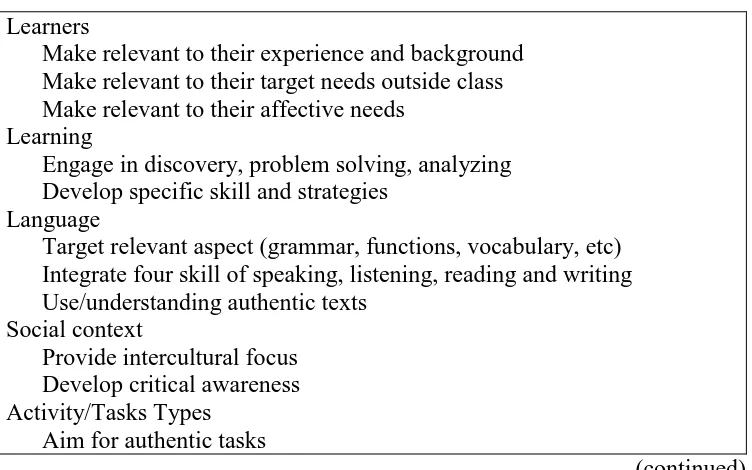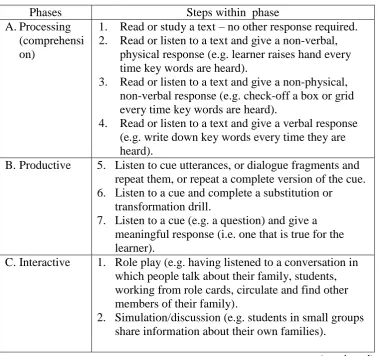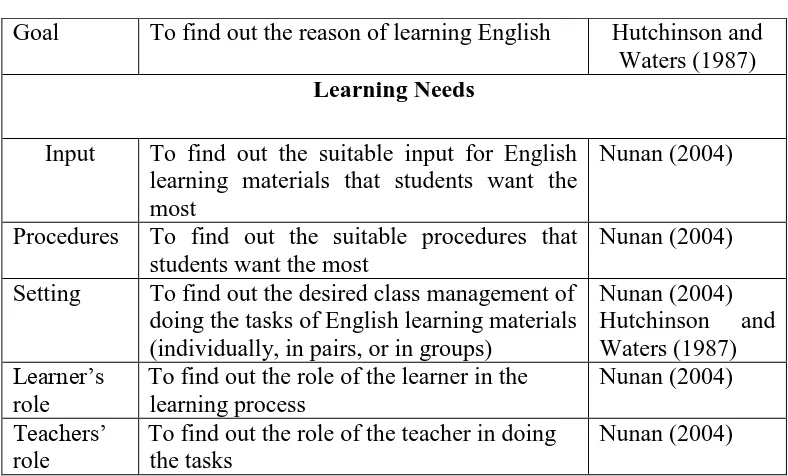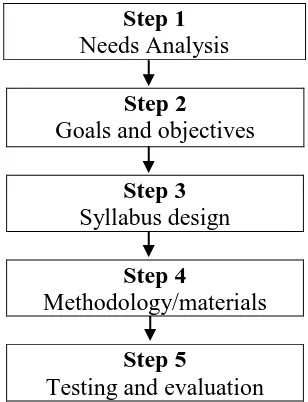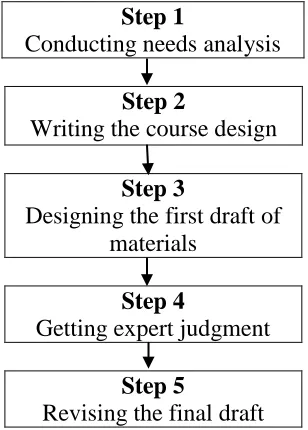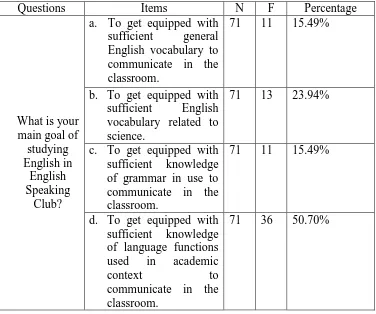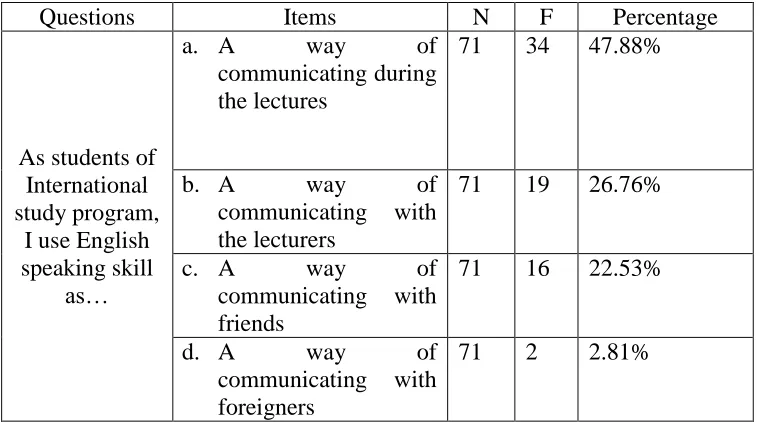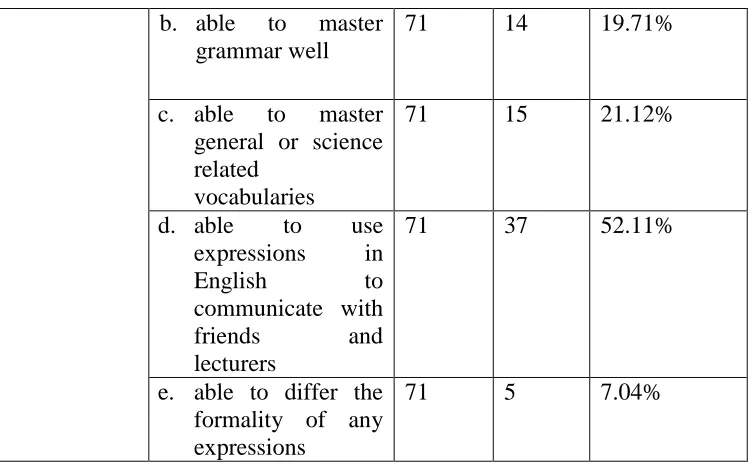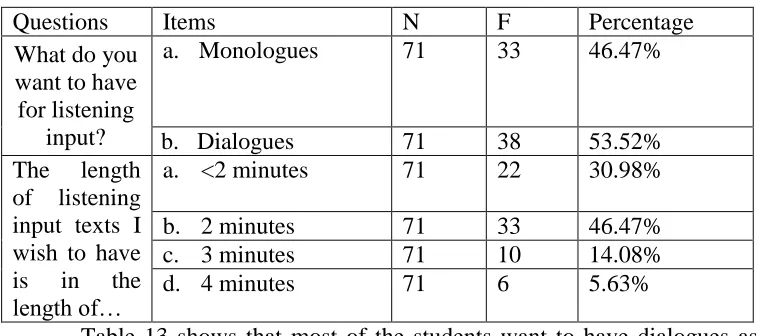A Thesis
Presented as a Partial Fulfillment of the Requirements for the Attainment of the Sarjana Pendidikan Degree in English Education
by
Laila Fitria Mufidah 09202241008
ENGLISH EDUCATION DEPARTMENT FACULTY OF LANGUAGES AND ARTS YOGYAKARTA STATE UNIVERSITY
v
“We are all connected; To each other, biologically. To the earth, chemically. To the rest of the universe atomically”.― Neil DeGrasse Tyson.
“Remember to look up at the stars and not down at your feet. Try to make sense of what you see and wonder about what makes the universe exist.
Be curious. And however difficult life may seem, there is always something you can succeed at. It matters that you don't just give up.”
vi I dedicate this thesis to:
vii
would not be possible without the support of many people. First of all, I would like to
express my highest appreciation to Dr. Margana, M.Hum.,M.A. for his valuable and
constructive suggestions during the planning and development of this thesis. His
willingness to give his time so generously has been very much appreciated. My
deepest gratitude is also devoted to Ella Wulandari, S.Pd., M.A. and B. Yuniar
Diyanti, S.Pd., M.Hum. as material experts who gave me guidance and suggestions
for the improvement of my thesis as well.
Then, I would like to express my sincerest appreciation to my parents, my
brothers for their love, support and encouragement throughout my study. Moreover, I
am particularly grateful for the assistance given by my best friends, thank you so
much for not getting bored supporting me in this way. I also would like to extend my
thanks to friends of mine in the English Education Department, especially my
classmates for their companion and wonderful friendship. To students of International
Biology, Chemistry, Physics and Science Education classes, thank you so much for
the participation. I will always keep you all in my heart.
Finally, I invite the readers to give critical comments and suggestions from
those who are interested in this topic. However, I expect that this thesis will give
viii
RATIFICATION ... iii
PERNYATAAN ... iv
MOTTOS ... v
DEDICATIONS ... vi
ACKNOWLEDGEMENTS ... vii
TABLE OF CONTENTS ... viii
LIST OF TABLES ... xi
LIST OF FIGURES ... xiii
LIST OF APPENDICES ... xv
ABSTRACT ... xiv
CHAPTER I ... 1
A. Background of the Study ... 1
B. Identification of the Problems ... 4
C. Limitation of the Problems ... 5
D. Formulation of the Problem ... 5
E. Objectives of the Study ... 5
F. Significance of the Study ... 6
CHAPTER II ... 7
A. Literature Review ... 7
1. Speaking ... 7
a. The Nature of Speaking ... 7
ix
a. Definition of English for Specific Purpose ………... 17
b. The Categorization of English for Specific Purpose………... 19
c. Teacher’s Role in ESP ………... 19
d. Learner’s Role in ESP………... 21
e. Needs Analysis ………... 22
3. Material Development ……….………... 25
a. Good Materials ………... 25
b. The Roles of Materials ………... 30
c. Principles of Materials Development ………... 31
d. Materials Design Model ………... 32
e. Materials Evaluation ………... 33
4. Task-Based Language Teaching ………... 35
a. Definition of Task ………... 35
b. Principles of Task-Based language Teaching ………... 35
c. A Framework of Task-Based Learning ………... 37
d. Components of Task ………... 41
e. Developing Unit of Materials ………... 43
f. Task Grading and Sequencing ………... 45
g. Component of a Unit ………... 46
h. Task Continuity ………..……... 48
i. Unit Design ………... 49
5. Tutoring in International Science Classes ………... 51
a. Tutoring ………... 51
b. Types of Small Group Teaching ………... 54
x
CHAPTER III ... 63
A. Type of the Study ... 63
B. Population and Sample of the Study ... 63
C. Setting of the Study ... 64
D. Instruments of the Study ………... 64
E. Data Collection ... 66
F. Data Analysis Technique ………... 66
G. Research Procedures ………... 68
CHAPTER IV ... 70
A. Research Findings ………... 70
1. The Results of Needs Analysis ………... 70
a. Target Needs ………... 70
b. Learning Needs ………... 75
2. Course Grid ………... 84
a. Unit 1 ………... 85
b. Unit 2 ………... 85
c. Unit 3 ………... 86
d. Unit 4 ………... 87
3. The Design of the Unit ……….…... 87
4. The First Draft of the Materials ……….……... 89
5. The Expert Judgment ………..………... 90
a. The Results of Expert Judgment of Unit 1 ……….……... 90
b. The Results of Expert Judgment of Unit 2 ……….…... 93
xi
7. The Final Draft of the Materials ………... 109
B. DISCUSSION ………. 110
CHAPTER V ... 116
A. Conclusions ... 116
B. Implications ………... 120
C. Suggestions ………... 121
REFERENCES ... 122
xii
Table 3: Phases of Students’ Activities Proposed by Nunan ……... 49
Table 4: The Organization of The Needs Analysis Questionnaire ………… 65
Table 5: The Organization of The Expert Judgment Questionnaire .………. 65
Table 6: Quantitative Data Conversion ………... 68
Table 7: Students’ View about Target Goals………. 71
Table 8: Students’ view about English Speaking skill usage ………. 72
Table 9: Students’ View about the Importance of Learning English…... 72
Table 10: Students’ current levels of English Proficiency ………. 73
Table 11: Students’ Difficulties in Learning English ...……….. 73
Table 12: Students’ General Wants in Learning English ……… 74
Table 13: The Data of the Learning Needs (Listening Input) ……… 75
Table 14: The Data of the Learning Needs (Speaking Input) ……… 76
Table 15: Topics to be Discussed ………... 77
Table 16: The Importance of Picture Availability ………... 78
Table 17: Students’ View about Language Functions to Use …………... 78
Table 18: Learning Needs (Listening Activity) ………... 79
Table 19: The Learning Needs (Speaking Activity) ………... 80
Table 20: The Learning Needs (Vocabulary Activity) ………... 80
Table 21: The Learning Needs (Pronunciation Activity) ………... 81
Table 22: The Learning Needs (Grammar Activity) ……….. 82
Table 23: The Learning Needs (Setting) ……… 82
Table 24: The Learning Needs (Tutor’s Role)………... 83
Table 25: The Learning Needs (Learners’ Role)……… 84
xiii
Table 30: The Appropriateness of the Content of Unit 2 ………... 93
Table 31: The Appropriateness of the Presentation of Unit 2 ……… 94
Table 32: The Appropriateness of the Language of Unit 2 ……… 95
Table 33: The Appropriateness of the Layout of Unit 2 ……… 96
Table 34: The Appropriateness of the Content of Unit 3 ………..…. 96
Table 35: The Appropriateness of the Presentation of Unit 3 ……… 97
Table 36: The Appropriateness of the Language of Unit 3 ……… 98
Table 37: The Appropriateness of the layout of Unit 3 ……….……. 99
Table 38: The Appropriateness of the Content of Unit 4 ………..…………. 99
Table 39: The Appropriateness of the presentation of Unit 4 ……… 100
Table 40: The Appropriateness of the Language of Unit 4 ……… 101
Table 41: The appropriateness of the layout of Unit 4 ………...……… 102
Table 42: The Appropriateness of the Whole Materials ……….……… 102
Table 43: The Experts’ Suggestions of Unit 1………...……… 104
Table 44: The Revision of Unit 1 ………...……… 104
Table 45: The Experts’ Suggestions of Unit 2…………...……… 106
Table 46: The Revision of Unit 2 ………...……… 106
Table 47: The Experts’ Suggestions of Unit 3……...……… 107
Table 48: The Revision of Unit 3 ………...……… 108
Table 49: The Experts’ Suggestions of Unit 4 ... 108
xiv
Figure 3: Designing Course Steps by Masuhara (In Tomlinson, 1998: 247) . 68
xv
xvi By
Laila Fitria Mufidah 09202241008
ABSTRACT
The objectives of this study are: (1) to find out the target and learning needs of 4th semester students of international science classes of Yogyakarta State University (2) to develop appropriate English speaking materials for tutorial practices for 4th semester students of international science classes.
The type of this study is Research and Development (R&D). The subjects of the research were the 4th semester students of international science classes in the academic year of 2012/ 2013 at Yogyakarta State University. This study was carried out by employing questionnaires. The data were analyzed using quantitative data analysis.
Based on the research findings, appropriate English speaking materials for tutorial practices consist of several sections, namely opening task, main task, study task, practice task, and closing task. The effective objectives of the developed materials are asking for and giving description, asking for and giving explanation, discussing and presenting. The effective inputs are the input which are in form of dialogue or monologue and has less than 450 words in length with list of vocabulary with the meanings and phonetic transcription. Acting out dialogues in pair, translating English words based on the context of the text, answering comprehension questions, having dialogues, and practicing dialogues (role playing) are the effective activities for them. The effective setting for the task is working in pairs. The effective learners’ role is that the students are encouraged to be a problem solver in doing the activities. The effective teacher’s role is to be active in observing and commenting to the
1
chapter includes the background of the study, the problem identification, the
limitation of the problem, the formulation of the problem, research objectives, and
research significance.
A.Background of Study
Nowadays, in the competitive global era of the 21st century, the growth of a country depends on the quality of its people – how well educated they are.
Because of that, educational institutions at all levels of education have an
important influence on the country’s own development. Indonesia, as one of
ASEAN developing countries, dreams about the growing number of ‘world class
universities’ as a way to improve to the quality of its education.
At this moment in time, “world-class university” has become a noticeable
term among universities all over the world. Professor Don Markwell of the
University of Western Australia, on his paper entitled “Working Together to
Become ‘World Class’ Universities” indentified six educational attributes of a
‘world class’ university i.e. (1) high quality of students, (2) high quality of
academic staff, (3) high quality of courses, (4) high quality of teaching, (5) a high
degree of student engagement both in their studies and in the extra-curricular life
of the university community, and (6) a strong emphasis on equity, access, and
In line with Markwell’s characteristics of a ‘world class’ university,
Yogyakarta State University along with its vision, envisions that the university
enjoys a world class education with piety, autonomy, and intellectuality as the
foundation. Therefore, to objectify the vision of Yogyakarta State University,
several things were done including the design of international classes. The
international classes being offered are Accounting Education of Faculty of Social
Science, Mathematics Education Biology Education, Chemistry Education,
Physics Education, and Science Education of Faculty of Mathematics and
Science.
As a result, the existence of international classes encourages students to be
given wider opportunities to improve their English speaking skills since the
language is used as the medium of instruction at these classes and also a main
language in the academic and daily context, especially during the lectures. So, it is
not daring to say that the ability to speak English is a necessity. “Language is
arguably the defining characteristic of the human species and knowledge of
language in general, as well as ability to use one’s first and, at least one other
language, should be one of the defining characteristics of the educated individual”
(Nunan 1999:71).
Nowadays, English holds the position as an international language. Hence,
learning English forms a permanent part in of all types of curriculums, from
primary schools to universities. Therefore, to keep up with the pace of rapidly
lifetimes. Hence, to enhance speaking skills students should always practice
speaking in English on a daily basis.
However, although English is used as a language instruction in the
classroom, students of international classes of Science Education, Chemistry
Education, Biology Education and Physics Education of Facutly of Mathematics
and Science, Yogyakarta State University still have difficulties in speaking
English. Things such as inadequate vocabulary and grammar inaccurately become
prevalent concerns among the students. Many of them face difficulties in
producing English sentences, as they are often inhibited about trying to say things
in a foreign language in the classroom; worried about mistakes or simply shy of
the attention that their speeches attract.
Therefore, to facilitate the needs of the 4th semester students of international classes in improving their English speaking ability, in the academic
year of 2012/2013, Center for Language Development of Yogyakarta State
University has come up with a new idea of designing an English speaking
program, which is called ESC (English Speaking Club). The program consists of
six study programs of international class i.e. Mathematics Education, Accounting
Education, Biology Education, Chemistry Education, Physics Education, and
Science Education. Those study programs are divided into three groups, i.e.
Mathematics, Accounting, and Science consisting of Biology Education,
Chemistry Education, Physics Education, and Science Education.
In the first year of its running, the program is held every week with total of
are conducted in a classroom and outdoor activity which is conducted in a tourism
area. Each class consists of at least ten students and a tutor from 9th semester
students of English Department, Faculty of Languages and Arts, Yogyakarta State
University In the classroom activities, each student is given a coursebook consists
of tasks and a tutor to assist them in doing the activities. While in the outdoor
activities, students are given the opportunity to develop their speaking skills by
interviewing foreigners.
Since the speaking program for students of international classes is a new
program, alternative relevant English materials are needed for better speaking
activities. Thus, this study is aimed to develop English speaking tutorial materials
which can be used by the participants and tutors of English Speaking Club at
Yogyakarta State University majoring science.
B.Identification of the Problems
In designing a new program, Center for Language Development needs to
develop materials to conduct the program. Therefore, Center for Language
Development together with students of English Education Department and
lecturers of English Education Department work together in developing materials
in the form of coursebook for the program. Those materials are compiled from
several resources such as websites and English speaking books. The topics and
themes of each unit in the materials are designed from the easier to the more
difficult based on the students’ needs and interests. The developed materials focus
on three international classes i.e. International Mathematics Education,
are designed in the form of tutorial coursebook consisting of tasks needed to be
done by the students to develop their speaking skills.
However, as a new program, alternative materials are needed to be used by
tutors and students besides the materials developed by lecturers and students of
English Department as mentioned above. Therefore, the researcher aims to
develop materials for international science classes.
C.Limitation of the Problems
Based on the problems stated above, the limited materials available for
students to develop their speaking skills, leads to the needs of other alternative
materials that can be used during the English speaking tutorial activities. Thus, it
is the starting point from which the researcher wants to conduct this research.
However, due to the limited of time and energy, this conducted research focuses
on developing speaking materials for students of international science classes of
Yogyakarta State University which particularly designed based on their needs,
interests and proficiency.
D.Formulation of the Problem
The problems are formulated as follows.
1. What are the learning needs of students of international science classes in
English Speaking Club?
2. What are the target needs of students of international science classes in
English Speaking Club?
3. What are the appropriate English materials for the students of international
E.Objectives of the Research
In relation in to the limitation of the problem mentioned above, the
objectives of this research are:
1. to identify learning needs of 4th semester students of international science classes of Yogyakarta State University in English Speaking Club,
2. to identify the target needs of 4th semester students of international science classes of Yogyakarta State University in English Speaking Club, and
3. to develop appropriate materials for 4th semester students of international science classes of Yogyakarta State University in English Speaking Club.
F. Significance of the Research
This research is expected to give a valuable contribution to the following
parties:
1. Theoretically, to the English speaking tutorial practices of English Speaking
Club, this result will add more reference about developing English speaking
materials for international science classes of Yogyakarta State University.
2. Practically, to the English Speaking Club tutors, who give speaking tutorial
to international science classes, the result of this study can be used as a
reference as to what English speaking tutorial materials for the English
Speaking Club of international science of Yogyakarta State University
7
that underline this study. The theoretical reviews cover the issues of speaking,
content-based instruction, English for specific purposes, materials
development, task-based language teaching, and tutoring in international
science classes.
A. Literature Review 1. Speaking
a. The Nature of Speaking
Speaking is an interactive process of constructing meaning that involves
producing and receiving and processing information (Brown, 1994; Burns &
Joyce, 1997). Its form and meaning are dependent on the context in which it
occurs, including the participants themselves, their collective experiences, the
physical environment, and the purposes for speaking. It is often spontaneous,
open-ended, and evolving. However, speech is not always unpredictable.
Language functions (or patterns) that tend to recur in certain discourse
situations (e.g., declining an invitation or requesting time off from work), can
be identified and charted (Burns & Joyce, 1997). Speaking requires that
learners not only know how to produce specific points of language such as
grammar, pronunciation, or vocabulary (linguistic competence), but also that
they understand when, why, and in what ways to produce language
conventions different from written language (Burns & Joyce, 1997; Carter &
McCarthy, 1995; Cohen, 1996).
Brown (2001: 267) cites that when someone can speak a language it means
that he can carry on a conversation reasonably competently. In addition, he
states that the benchmark of successful acquisition of language is almost
always the demonstration of an ability to accomplish pragmatic goals through
an interactive discourse with other language speakers.
Brown (2007: 237) also states that social contact in interactive language
functions is a key importance and in which it is not what you say that counts
but how you say it what you convey with body language, gestures, eye contact,
physical distance and other nonverbal messages. There are three components to
make fluent in producing speech, namely vocabulary, pronunciation, and
grammar.
According to Walter (1973:11), speaking is one way of learning about one
self. In speaking, someone must face problems that have history and relatively
to other people, groups, and the predictions we have formed for living together.
According to Nunan (1989: 32), successful oral communication involves
several points as presented below.
1) The ability to articulate phonological features of the language
comprehensibly.
2) Mastery of stress, rhythm, intonation patterns.
3) An acceptable degree of fluency.
5) Skills in taking short and long speaking turns.
6) Skills in the management of interaction.
7) Skills in negotiating meaning.
8) Conversational listening skills (successful conversations require good
listeners as well as good speakers).
9) Skills in knowing about and negotiating purposes for conversations.
10) Using appropriate conversational formulae and fillers.
According to Hornby (1995:826), speaking is making use of words in an
ordinary voice, offering words, knowing and being able to use a language
expressing one-self in words, and making speech. Therefore the writer infers
that speaking uses the word and produces the sound to express ourselves either
ideas, feeling, thought and needs orally in an ordinary voice. Furthermore,
success in communication is often dependent as much on the listener as on the
speaker.
According to Harmer (2001), when discussing the elements of speaking
that are necessary for fluent oral production, distinguishes between two aspects
– knowledge of ‘language features’, and the ability to process information on
the spot, it means ‘mental/social processing’.
The first aspect, language features, necessary for spoken production
according to Harmer (2001, 269-270) are presented below.
1) Connected speech – conveying fluent connected speech including
assimilation, elision, linking ‘r’, contractions and stress patterning –
2) Expressive devices – pitch, stress, speed, volume, physical – non-verbal
means for conveying meanings (supersegmental features);
3) Lexis and grammar – supplying common lexical phrases for different
functions (agreeing, disagreeing, expressing shock, surprise, approval, etc.);
4) Negotiation language – in order to seek clarification and to show the
structure of what we are saying.
b. Classroom Speaking Activities
Harmer (2001: 348-352) states six classroom speaking activities as follows.
1) Acting from a script
Acting scripts consists of the activities of playing script and acting
out the dialogues. The teacher acts as the director, drawing attention to
appropriate stress, intonation, and speed, and the students perform the
dialogue, as if the lines they speak have real meaning. When choosing
who should come out to the front of the class we need to be careful not
to choose the shyest students first, and we need to work to create the
right kind of supportive atmosphere in the class. We need to give
students time to rehearse their dialogues before they are asked to
perform them. By giving students practice in these things before they
give their final performances, we ensure that acting out is both learning
and language producing activity.
As one of activities that can help students relaxed in learning the
language, games are designed to provoke communication between
students, so that the students has to talk to a partner in order to solve a
puzzle, draw a picture (describe and draw), puts the things in right order
(describe and arrange), and find similarities and differences between
pictures.
3) Discussion
According to Hammer (2001: 272), discussion range is divided
into several stages from highly formal, whole-group staged events to
informal small-group interactions. Discussion is probably the most
commonly used activities in the oral skill class where students are
allowed to express their opinions.
The problem in conducting the discussion is the students’
reluctant to give opinion in front of the whole class, particularly when
the students are not mastering the topic of a discussion.Therefore, to
encourage the students is to provide activities which force the students
in expressing the ideas through the topics such as their daily activity,
their hobbies or the situation of their class.
4) Prepared talks
Students make a presentation on a topic of their own choice. Such
talks are not designed for informal spontaneous conversation because
they are prepared, they are more ‘writing-like’ than this. However, if
5) Questionnaires
Questionnaires are useful because, by being pre-planned, they
ensure that both questioner and respondent have something to say each
other. Students can design questionnaires on any topic that is
appropriate. As they do so the teacher can act as a resource, helping
them in the design process. The result obtained from questionnaires can
then form the basis for written work, discussions, or prepared talks.
6) Simulation and Role Play
In simulation and role play, students pretend that they are in a
different situation, either as themselves or playing the role of someone
different. It can encourage students’ general oral fluency, or to train
students for specific situations. Teachers can choose an activity that
related to the topic and objective of the lesson, but they must consider
the situation, condition of the students and materials that are being
taught. Some students find it very comfortable to use language in a
simulated environment, playing the role of someone else.
Ur (1996) lists the characteristics of a successful speaking activity
as presented below.
a) Learners talk a lot. As much as possible of the period of time allotted
to the activity is in fact occupied by learner talk.
b) Participation is even. Classroom discussion is not dominated by a
minority of talkative participants: all get a chance to speak, and
c) Motivation is high. Learners are eager to speak: because they are
interested in the topic and have something new to say about it, or
because they want to contribute to achieving a task objective.
d) Language is of an acceptable level. Learners express themselves in
utterances that are relevant, easily comprehensible to each other, and
of an acceptable level of language accuracy.
c. Types of Classroom Speaking Performance
Brown (2001: 271-274) describes six categories of classroom
speaking performances. Those six categories are as follows.
1) Imitative
This category includes the ability to practice an intonation and
focusing on some particular elements of language form. That is just
imitating a word, phrase or sentence. The important thing here is
focusing on pronunciation. The teacher uses drilling in the teaching
learning process. The reason is by using drilling, students get
opportunity to listen and to orally repeat some words.
2) Intensive
This is the students’ speaking performance that is practicing some
phonological and grammatical aspects of language. Intensive speaking
can be self-initiated or it can even form part of some pair work activity,
where learners are ‘going over’ certain forms of language.
Responsive performance includes interaction and test
comprehension but at the somewhat limited level of very short
conversation, standard greeting and small talk, simple request and
comments. A good deal of student speech in the classroom is
responsive short replies to teacher-or students-initiated questions or
comments. These replies are usually sufficient, meaningful and do not
extent into dialogues.
4) Transactional (dialogue)
Transactional language, carried out for the purpose of conveying or
exchanging specific information, is an extended form of responsive
language.
5) Interpersonal (dialogue)
Interpersonal dialogue is carried out for the purpose of marinating
social relationships than for the transmission of facts and information.
The forms of interpersonal speaking performance are interview, role
play, discussions, conversations and games.
6) Extensive (monologue)
Students are called on to give extended monologues in the form of
oral reports, summaries, and story telling and short speeches.
d. Principles for Designing Speaking Techniques
1) Use techniques that cover the spectrum of learner needs, form
language-based focus on accuracy to message-based focus on
interaction, meaning, and fluency. Make sure that the tasks include
techniques designed to help students to perceive and use the building
block. At the same time, do not make the students feel bored with
repetitious drills. Teachers should make any drilling as meaningful as
possible.
2) Provide intrinsically motivating techniques. Try at all times to appeal to
students’ ultimate goals and interests, to their need for knowledge, for
status, for achieving competence and autonomy, and for “being all that
they can be.” Even in those techniques that don’t sent students into
ecstasy, help them to see how the activity benefits them. Inform the
students why we ask them to do certain things; so they know how the
activity benefits them.
3) Encourage the use of authentic language in meaningful context. It takes
energy and creativity to design authentic contexts and meaningful
interaction, but with the help of storehouse of teacher resource material
it can be done. Even drilling can provide a sense of authenticity.
4) Provide appropriate feedback and correction. In most EFL situations,
students are dependent on the teacher for useful linguistic feedback.
Feedback can be found outside of the classroom but it is important to
inject the kinds of corrective feedback that are appropriate for the
5) Capitalize on the natural link between speaking and listening. Many
interactive techniques that involve speaking skills include listening.
Don’t lose out on opportunities to integrate these two skills. As you are
perhaps focusing on speaking goals, listening goals may naturally
coincide, and the two skills can reinforce each other. Skills in producing
language are often initiated through comprehension.
6) Give students opportunities to initiate oral communication. Part of oral
communication competence is the ability to initiate conversations, to
nominate topics, to ask questions, to control conversations, and to
change the subject. As you design and use speaking techniques, ask
yourself if you have allowed students to initiate language.
7) Encourage the development of speaking strategies. The concept of
strategic competence is one that few beginning language students are
aware of. They simply have not thought about developing their own
personal strategies for accomplishing oral communicative purposes.
Teachers should help their students develop strategic competence to
accomplish oral communicative purposes.
2. English for Specific Purposes (ESP)
a. Definition of English for Specific Purposes
Hutchinson and Waters (1987:19) defined ESP as an approach to
language teaching in which all decisions as to content and method are based
on the learner's reason for learning. According to Basturkmen (2010:17), ESP
language learners needs to function effectively in their discipline of study,
professions or workplaces. According to Richards and Schmidt (2002:181),
English for specific purpose is the role of English in a language course or
program of instruction in which the content and aims of the course are fixed
by the specific needs of a particular group of learners. From the above
statements, it can be concluded that ESP is an approach to language teaching
which aims to meet the needs of a particular learner. Beside, Dudley-Evans
and St John (1998:3) state that the definition of ESP can be seen through two
characteristics as presented below.
1) Absolute characteristics
a) ESP is designed to meet specific needs of the learner.
b) ESP makes use of the underlying methodology and activities of the
disciplines it serves.
c) ESP is centered on the language (grammar, lexis, and register), skills,
discourse and genres that are appropriate to activities.
2) Variable characteristics
a) ESP may be related or designed for specific disciplines.
b) ESP may use, in specific teaching situations, a different methodology
from that general English.
c) ESP is likely to be designed for adult learners, either at a tertiary level
institution or in a professional work situation; it could be used for
learners at secondary school level.
e) Most ESP courses assume basic knowledge of the language system,
but it can be used with beginners.
In contrast to students learning English for general purposes,
learning the language in order to pass a general examination is the primary
goal, the goal of ESP students is usually studying English in order to carry
out a particular role (Richards, 2001:28).
b. The Categorization of English for Specific Purpose
Hutchinson and Waters (1987) categorize ESP based on two things
i.e. learners’ needs and learners’ specialism as presented below.
1) ESP Based on Learners’ Needs
There are two types of ESP; they are English for Academic
Purposes (EAP) and English for Occupational Purposes (EOP). In this
study, students of international science classes need English to
communicate with their lecturers and friends.
Therefore, the English needed is categorized into English for
Academic Purposes (EAP).
2) ESP Based on Learners’ Specialism
There are three categories of ESP that is based on learners’
specialism; they are English for Science and Technology (EST), English
for Business and Economics (EBE), and English for Social and Science
(ESS). In this study, students of international science classes use English
used by the international science classes is categorized into English for
Science and Technology (EST).
c. Teacher’s Role in ESP
The role of an ESP teacher is different from a general English
teacher. According to Hutchinson and Waters (1987:157), an ESP teacher
deals with needs analysis, syllabus design, materials writing or adaptation
and evaluation. It means that the teaching of ESP also differ from general
English teaching. Based on one of ESP criteria by Robinson (1992:2), ESP
is “ordinarily goal directed.” It means that in teaching ESP, students
achieve a certain goal. They need English for their study and their purpose
not just because they are interested in General English.
Moreover, Dudley-Evans and St John (1998:13-16) proposed five
key roles of an ESP teacher as follows.
1) The ESP teacher as teacher
The main focus as a teacher is helping students to learn. It means
that the teacher is not in the position of being the “primary knower” of
the carrier content of the materials. In this situation, ESP teacher has
the opportunity to draw on students’ knowledge of the content in order
to generate genuine communication in the classroom.
2) The ESP teacher as a researcher
Before designing course or writing materials, the ESP teacher
to observe the situation in which students use the identified skills and
analyze the discourse of the texts that students use.
3) The ESP teacher as a course designer and a materials provider
The ESP teacher often has to plan the course he or she teaches and
provides materials for it. It is rarely possible to use published materials
or textbooks. The role of the ESP teacher as provider of material thus
involves choosing suitable published materials, adapting materials when
published materials are not suitable or even writing materials.
4) The ESP teacher as a collaborator
The ESP teacher collaborates with subject experts as
team-teaching in order to get more understanding on subject matter.
5) The ESP teacher as an evaluator
The ESP teacher is often involved in various types of evaluation,
including the testing of students and the evaluation of courses and
teaching materials. Evaluation course design and teaching materials
should be done while the course is being taught, at the end of the
course and after the course has finished. The ESP teacher also needs to
be able to device achievement test to assess how much learners have
gained from a course.
d. Learner’s Role in ESP
In ESP teaching process, the learner is the fundamental component
in this process and the learner’s needs should be gained for getting language
primarily language learners; they have been learners of other disciplines and
this has to be a major consideration in the devising and delivering of a
course.”
Furthermore, Johnson and Paulston as quoted by Richards
(2006:28) divide learners’ roles in ESP into five i.e. first, the learner is a
planner of his own learning program and thus ultimately assumes
responsibility for what he does in the classroom. Second, the learner is the
monitor and evaluator of his own progress. Third, the learner is a member of
group and learns by interacting by other learners. Fourth, the learners learn
from the teacher from other students. Fifth, the learners learn from other
teaching sources.
e. Needs Analysis
Needs analysis is a systematic way of gathering information about
learner’s needs, interpreting the information and then making course decision
based on the interpretation in order to meet the needs. As Richards and
Schmidt (2002:352) state, a needs analysis is the process of determining the
needs for which learners require a language and make priority scale of need.
The process is normally required before a syllabus can be developed for
language teaching.
In ESP, learner’s needs are described in terms of what the learner
are able to do with the language at the end of the study (Richards, 2001:33).
Hutchinson and Waters (1987: 55–58) suggest conducting ‘needs analysis’ by
1) Target needs
The target needs refer to what the learners need to do in the target situation.
a) Necessities
It is what the learner has to know in order to function effectively in
the target situation. It is a matter of observing what situations the
learner needs to function in and then analyzing the constituent parts of
them.
b) Lacks
It is what the learner knows already in the target situation. It is the gap
between the target proficiency and the existing proficiency of the
learners. What the learners know already should be recognized to
decide which of the necessities the learners’ lack. It is illustrated as a
gap between the ideal situation or target situation with the real
conditions.It would be useful to decide which of the necessities that
the learner lacks.
c) Wants
The learners may have a clear idea of the necessities of the target
situation and their lacks. They also have a view to what they want or
they need. The learners’ motivation is important in the learning
process, so learners’ perceived wants cannot be ignored (Hutchinson
and Waters, 1987: 57). Wants related to what the learner wants to
learn.
According to Hutchinson and Waters (1987: 60-62), learning needs
indicates how the learners are going to get from their starting point (lacks)
to the destination (necessities). To have useful analysis of learners needs,
the needs, potential and constraints must be considered. Moreover, the
learners must choose their route according to the conditions of the learning
situations, their knowledge, skills and strategies, and their motivation.
Basturkmen (2010:19) proposes the process of needs analysis, as
presented below.
a) Target situation analysis.
Identification of tasks, activities and skill learners are be using
English for; what the learners should ideally know and be able to
do.
b) Discourse analysis.
Descriptions of the language used in the above.
c) Present situation analysis.
Identification of what the learners do and do not know and can or
cannot do in relation to the demands of the target situation.
d) Learner factor analysis.
Identification of learner factors such as their motivation, how they
learn and their perceptions of their needs.
Identification of factors related to the environment in which the
course runs. Consideration of what realistically the ESP course and
teacher can offer.
A needs analysis is a pre-course design process in which
information is gathered to help the teacher or course developer decide
what the course should focus on, what content in terms of language or
skills to include and what teaching/learning methods to employ. The needs
analysis also plays a role in refining the ESP course.
3. Material Development
According to Tomlinson (1998:2), materials development refer to
anything which done by writers, teacher or learners to provide sources of
language input and to promote language learning. Nunan (1991:208) argues
that material is an important element within the curriculum and often the most
visible aspect of it.
a. Good Materials
The term ‘language-learning materials’ is commonly only in form
of coursebook. However, the language-learning materials are more than it.
Materials are a set of product used in language teaching and learning.
Materials can be in the form of newspapers, workbooks, photocopied
exercises, etc. Materials refer to anything which is used by the teachers or
learners to facilitate the learning of a language that is able to improve the
Hutchinson and Waters (1987:107) identify some principles in the
actual writing of the materials. First, materials provide a stimulus to learning.
Good materials do not teach; they encourage learners to learn. Good materials,
therefore, contain, interesting texts, enjoyable activities which engage the
learners’ thinking capacities, opportunities for learners to use their existing
knowledge and skills, and content which both leaner and teacher can cope
with. Second, materials help to organize the teaching and learning process, by
providing a clear and coherent unit structure guides teacher and students
through various activities to maximize the chances of learning. Third,
materials embody a view of the nature of language and learning. Fourth, they
should reflect the nature of the learning task. Fifth, materials can a have a very
useful function in broadening the basis of teacher training, by introducing
teachers to new technique. Sixth, the provide models of correct and
appropriate language use.
Tomlinson (1998:7-21) summarizes of the basic principles of the
materials development for the teaching of languages as stated below.
a) Materials should achieve impact. Impact is achieved when materials have
a noticeable effect on learners that is when the learners’ curiosity, interest,
and attention are attracted. If this is achieved there is a better chance that
some of the language in the materials are taken for processing. Further, it
is said that materials can achieve impact when they are new, varied,
b) Materials should help learners to feel at ease. Materials can help learners
to feel at ease in many ways, for example, texts and illustrations rather
than just texts, texts that the learners can relate with their own culture than
those that are culturally bound, materials that include examples rather than
without, and many others.
c) Materials should help learners to develop confidence. Quoting Dulay,
Burt, and Krashen 1982, Tomlinson (1998:9) said that relaxed and self
confident learners learn faster. Many learners feel relaxed and
self-confident if they think that the materials they learn are not too difficult but
just one step further or more difficult than they master. What is being
taught should be perceived by learners as relevant and useful. In ESP,
teachers of English can easily select materials that are relevant to the
specific choice of topics and tasks that the learners are also learning in
their field of study, therefore, the materials they learn must be relevant and
useful.
d) Materials should require and facilitate learner self-investment. Materials
that enable the learners to be interested in them can draw their attention,
can attract them to learn the materials and facilitate them to learn the
materials by themselves. Learners must be ready to acquire the points
being taught. To acquire the points being taught, the materials learned
should be i + 1 in which i represents what has already been learned and 1
each learner only learns from the new input what he or she is ready to
learn.
e) Materials should expose the learners to language in authentic use. A lot of
teaching/learning materials can provide exposure to authentic input
through the instructions, advice they give for the activities and the spoken
and the written texts included in the materials. The learner’s attention
should be drawn to linguistic features of the input. These linguistic
features should not become the main focus in the materials but the learners
should be made aware that linguistic features are needed to locate and to
make a generalization about the function of the linguistic features in the
main materials.
f) Materials should provide the learners with opportunities to use the target
language to achieve communicative purposes. After learning the materials,
learners should be given opportunities to practice the language they have
learned for communication in real life situation not just practicing it in the
classroom controlled by the teacher. Next, materials should take into
account that the positive effects of instruction are usually delayed. As it
can be observed in our daily teaching, learners learning a language is not
an instantaneous process but a gradual one. In order to facilitate the
gradual process of learning or acquiring a language, it is important to give
frequent and ample exposure to the instructed language features in
g) Materials should take into account that learners differ in learning styles.
Not all learners have the same learning styles. Language learning styles
include visual, auditory, kinesthetic (e.g. the learner prefers to do
something physical, such as following instructions), studial (e.g. the
learner likes to pay conscious attention to the linguistic features of the
language and wants to be correct), experiential, analytic, global, dependent
and independent.
h) Materials should take into account that learners differ in affective
attitudes. Learners attitudes vary in types and times. Ideal learners need
strong and consistent motivation, positive feelings towards the target
language, their teachers, their fellow learners, and the materials they are
learning. Realizing this fact, materials should provide choices of different
types of texts and types of activities. Then, materials should permit a silent
period at the beginning of instruction. The silent period is used to facilitate
the development of an effective internalized grammar and other language
elements which can help learners to achieve proficiency. The other
possible extension of the principle of permitting silence is to introduce
most new language points through activities which initially require
comprehension before production.
i) Materials should maximize learning potential by encouraging intellectual,
aesthetic and emotional involvement which stimulates both right and left
brain activities. This principle means that materials which encourage the
different states of consciousness in many different parts of the brain can
maximize recall.
j) Materials should not rely too much on controlled practice. This principle is
intended to state that it is still controversial to say that controlled practice
activities are valuable. The statements which state that most spontaneous
performance is attained by dint of practice (Sharwood-Smith, 1981) and
automaticity is achieved through practice (Bialystok, 1988) have no
evidence. However, many researchers agree with Ellis saying that
controlled practice appears to have little long term effect on the accuracy
with which new structures are performed (Ellis, 1990:192) and has little
effect on fluency (Ellis and Rathbone, 1987). Yet, controlled grammar
practice activities still feature significantly in popular coursebooks and are
considered useful by many teachers and by many learners.
k) Materials should provide opportunities for outcome feedback. Feedback
which is focused on the effectiveness of the outcome rather than just on
the accuracy of the output can lead to output becoming a profitable source
of input. Therefore, a learner who is successful to achieve a particular
communicative purpose gains positive feedback on the effectiveness of the
use of the language for further language outcome. In relation to this,
materials developer has to be sure that language production activities have
intended outcomes other than just practicing language.
Materials play important role in teaching learning process,
especially English teaching. There are four important roles of materials in the
ESP context proposed by Dudley-Evans and St. John (1998:170-172):
1) Source of language
In some situations, where English is a foreign language, ESP
classroom may be the only source of English. Materials then play a crucial
role in exposing learners to the language; it means that materials need to
present real language. Where the classroom is the primary source of
language, the materials also need to maximize exposure to the language by
providing additional materials.
2) Learning Support
As a learning support, materials need to be reliable, that is, to be
consistent and have some recognizable patterns. To enhance learning,
materials must involve learners in thinking about and using the language.
The activities need to stimulate cognitive not mechanical process. The
learners also need a sense of progression.
3) Stimulation and motivation
Materials need to be challenging to offer new ideas and
information, to encourage fun and creativity. The input must contain
concepts and knowledge that are familiar but it must also offer something
new, a reason to communicate, to get involve.
For self-study or reference, materials need to be complete, well laid
out and self explanatory. The learners want explanations, examples and
practice activities that have answer and discussion keys.
c. Principles of Materials Development
There are to five principles of materials development according to
Tomlinson (2010) as presented below.
1) Providing many opportunities for the learners to produce language in order
to achieve intended outcomes.
2) Making sure that these output activities are designed so that the learners
are using language rather than just practicing specified features of it.
3) Designing output activities so that they help learners to develop their
ability to communicate fluently, accurately, appropriately and effectively.
4) Making sure that the output activities are fully contextualized in that the
learners are responding to an authentic stimulus (e.g. a text, a need, a
viewpoint, an event), that they have specific addressees and that they have
a clear intended outcome in mind.
5) Trying to ensure that opportunities for feedback are built into output
activities.
d. Materials Design Model
The way materials organized and presented as well as the types of
content and the activities help to shape the students’ view of the target
language (Nunan, 1991: 210). Steps of materials design principles
1) Selecting the topic
2) Collecting data
3) Determining that students need to do in relation to the texts
4) Creating activities focusing on language elements
5) Creating activities focusing on learning skills/strategies
6) Creating application task
There are three approaches to course design i.e. language-centred
approach, skill-centred approach, and learning-centred approach
(Hutchinson and Waters, 1987: 73). In relation to this, Masuhara (in
Tomlinson, 1998: 247) says that the sequence of course design
recommended by experts can be summarized as the linear Model X as
follows.
Figure 1: Model X of a course design proposed by Masuhara (in
Tomlinson, 1988: 247)
Need analysis
Testing and evaluation Methodology/materials
e. Materials Evaluation
To know whether the materials design meet the learners’ needs, or
in other words, are suitable for them, an evaluation is needed in the end of the
design. In the last ten years a number of other writers have proposed
frameworks for materials evaluation. McGrath (2002: 31) distinguishes
between ‘general criteria (i.e. the essential features of any good
teaching-learning material)’ and ‘specific (or context related) criteria’ and, in relation
to choosing a coursebook, proposes a procedure which includes materials
analysis, first-glance evaluation, user feedback, evaluation using situation
specific checklists and, finally, selection. McDonough & Shaw (2003: 61)
suggest that the evaluators first conduct an external evaluation ‘that offers a
brief overview from the outside’ and then carry out ‘a closer and more
detailed internal evaluation’. They stress that the four main considerations
when deciding on the suitability of materials are usability, generalisability,
adaptability and flexibility. Cunningsworth (1995) insists on the importance
of collecting data about the context of learning and proposes a procedure
which includes a survey of the teaching/learning situation, a neutral analysis,
a belief-driven evaluation and a selection. Cunningsworth (1995) in Richards
(2001: 258) suggests four criteria for evaluating materials especially
textbooks as follows.
1) They should correspond to learners’ needs. They should match the aims
2) They should reflect the uses (present or future) that learners make of the
language. Textbooks should be chosen to help equip learners to use
language effectively for their own purposes.
3) They should take account of students’ needs as learners and should
facilitate their learning processes, without dogmatically imposing a rigid
‘method’.
4) They should have a clear role as a support for learning. Like teachers,
they mediate between the target language and the learner.
The following steps are used to ensure that the evaluation is
systemic and principled (Tomlinson, 1998:227-231).
Table 1: The Steps in Conducting an Evaluation of a Task
Step 1 Description of the task:
1. Contents (input, procedures, language activity) 2. Objective(s)
Step 2 Planning the evaluation (with references to the dimensions)
Step 3 Collecting information
Step 4 Conclusion and recommendations
4. Task-Based language Teaching a. Definition of Task
Richards and Schmidt (2002:539) said task is an activity which is designed
to help achieve a particular learning goal. It can be defined as an activity or
action that is carried out as the result of processing or understanding language.
In line with Breen (1987) in Nunan (2004:3) tasks refer to a range of work plans
which have particular objective, appropriate content, a special working
type to more complex activities. Beside, Nunan (2004:4) task is a piece of
classroom work that involves learners in comprehending, manipulating,
producing, or interacting in the target language while their attention is focused
on mobilizing their grammatical knowledge in order to express meaning, and in
which the intention is convey meaning rather than to manipulate form.
b. Principles of Task-Based language Teaching
According to Nunan (2004, 35-38) there are seven principles for planning
task-based lesson.
1) Scaffolding
Nunan means that learners need to have sufficient language to complete
the tasks. Since the learners focus on meaning when carrying out a task,
teachers may need to build extra support into the classroom materials to
provide learners with specific language forms and vocabulary that they are
likely to need in carrying out the given task.
2) Task dependency
Task dependency refers to the organization and sequencing of tasks.
Ideally, one task grows out of another. Thus, the ability to complete Task B
depends on the successful completion of Task A. Organizing tasks in this way
helps the instructor to ensure that tasks have outcomes.
3) Recycling
Nunan sees that a series of tasks should cluster around some issue or
opportunities for learning because some set of targeted language forms (e.g. a
vocabulary cluster, a certain grammar structure) is likely to occur regularly.
4) Active learning
Nunan reminds instructors that tasks are unit of works, and should thus
be structured to have learners do something.
5) Integration
Nunan conceives of integration as ways of connecting form and
meaning. While performing tasks, students should have the opportunity to
realize the relationships between linguistic form and communicative function
and semantic meaning.
6) Reproduction to Creation
Following widely accepted notions that learners need to comprehend
input and make form-meaning connections before they can produce the target
language for communicative purposes, Nunan reminds instructors to
sequence tasks in ways that move from reproduction activities (e.g.
comprehension of reading/listening to passages, sorting a series of sentences
into a logical dialogue) t9o production activities where learners create with
the language.
7) Reflection
Lastly, Nunan recommends that learners should have opportunities to
reflect on what they have learnt and how well they are learning it. If a
significant component of task-based language teaching focuses on learners
to reflect on the learning embodied in that outcome. This learning has both
content and performance dimensions.
c. A Framework of Task-Based Learning
The aim of the task based learning framework is to create the optimum
conditions for language learning. Willis (1996: 3) identifies these three
essential conditions as presented below.
1) Exposure to the target language
2) Opportunities to use the target language for expressing meaning
3) Motivation to engage with exposure and use what they know.
4) Focus on language form to prevent fossilisation
A brief description of the task based lesson according to Willis (1996:
52).
1) Pre-task
This serves as an introduction to the topic and task. It may involve
brainstorming, a pre-task, introduction of useful words and phrases,
preparation time or listening to native speakers doing the task. New
structures are not pre-taught.
2) Task cycle
This cycle has three essential phases and one further optional phase.
a) Task
Learners begin by carrying out a communication task, using
whatever language they already have, in pairs or groups. A task is a
According to Willis, (1996:26-28), there are six main types of task
as presented below.
(1) Listing (e.g. fact-finding)
(2) Ordering and sorting (e.g. sequencing items, actions or events,
categorizing and classifying items)
(3) Comparing (e.g. matching, finding similarities and differences)
(4) Problem solving (e.g. real life problems, completion task)
(5) Sharing personal experiences (e.g. telling past experience)
(6) Creative tasks (e.g. having projects)
Grammar exercises, practice activities are examples of
activities which are not tasks. Tasks have a specific objective that
must be achieved in a given time. Learners are free to choose
whatever language forms they like to achieve the goal of the task.
The emphasis is on meaning rather than form. The teacher monitors
discreetly and does not correct errors.
Closed tasks are highly structured with specific goals and
relatively predictable language forms. Open tasks are less
structured with less specific goals and less predictable language
forms.
At this stage, the teacher monitors and encourages attempts
to communicate meaning in the target language. While helping
students to formulate what they want to say, the teacher does not
b) Planning
Having completed the task, students prepare to report on the
outcome to the class how they did the task and what they
discovered/decided. Now the emphasis is on organisation and
accuracy. The teacher ensures the purposes of the report is clear,
advises students on language and helps them correct any errors they
make during this phase.
c) Report
Some or all of the groups report briefly to the whole class. The
others listen in order compare findings or conduct a survey. The
teacher may rephrase but not correct the language.
3) Language focus
According to Willis, these are sometimes called
consciousness-raising activities, language awareness activities i.e.
tasks that focus explicitly on language form and use. The language
focus consists of a sequence where language which has been used
during the pre-task and the task-cycle is analysed and a sequence
where the students practise the language which they looked at during
the analysis. In the Language focus stage, the learners observe and
talk about exact features of any listening or reading text which they
have looked at for the task and the teacher may present some form of
preparation of specific language features which the task has provoked.
